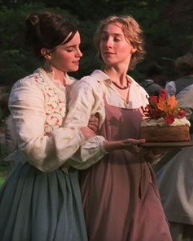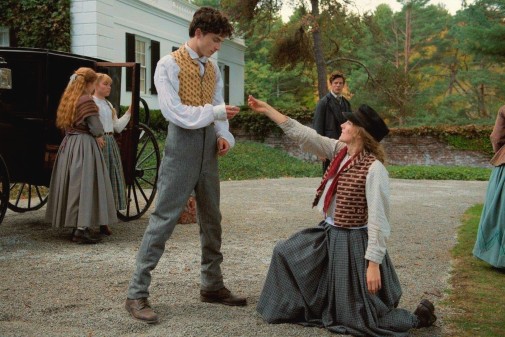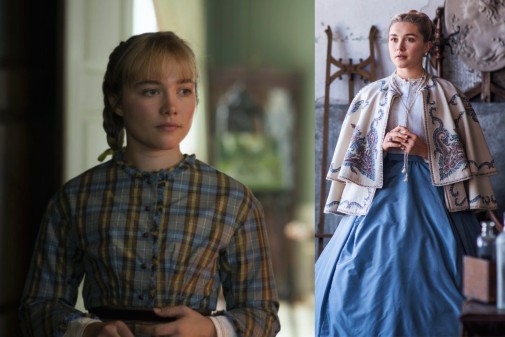 Last Sunday, the great Jacqueline Durran became a two-time Academy Award winner thanks to Little Women. As the umpteenth costume designer to tackle Louisa May Alcott's classic tale, Durran had the challenge of dressing these well-known characters in a bold reinterpretation. Eschewing the strict historical accuracy with which Collen Atwood tackled the subject in 1994, Jacqueline Durran evoked the fashions of the 1860s by infusing them with character-specific idiosyncrasies and a general sense of 21st-century modernity.
Last Sunday, the great Jacqueline Durran became a two-time Academy Award winner thanks to Little Women. As the umpteenth costume designer to tackle Louisa May Alcott's classic tale, Durran had the challenge of dressing these well-known characters in a bold reinterpretation. Eschewing the strict historical accuracy with which Collen Atwood tackled the subject in 1994, Jacqueline Durran evoked the fashions of the 1860s by infusing them with character-specific idiosyncrasies and a general sense of 21st-century modernity.
Her designs are not as bound to their filmmaker's contemporary styles as the Little Women of 1933 or 1949. However, there's no denying that the current iteration of the March sisters is filtered through the sensibilities of artists living in the 2010s…
Throughout her career, Jacqueline Durran has experimented with many different stylistic registers and approaches to the challenge of designing period costumes. Sometimes, as when she's working for Mike Leigh, there's an almost archaeological pursuit of historical accuracy, resurrecting fashions of the past with no adaptation to the tastes of current audiences.

In other cases, like the glamourous Anna Karenina, her stylization verges on the fantastical, abandoning realism in search of a spectacular fusion of costume and couture. For Greta Gerwig's Little Women, neither of these extremes was correct, so the designer returned to the same sort of methodology she had previously explored in Joe Wright's Pride & Prejudice and Atonement.
These costumes nod in the direction of real history but their feel is pleasantly anachronistic. The designs, partly inspired by the paintings of Winslow Homer, suggest what some stylish person of 2019 might have worn had they been temporally displaced in Louisa May Alcott's New England. No other character exemplifies this point as well as Timothée Chalamet's Laurie. The individual pieces of his attire reference the period, but the fit doesn't.


Shirts and trousers tend to be baggier than would have been the case, while his jackets and waistcoats work with the actor's waifish frame instead of forcing his figure into a more fashionable shape for Victorian eyes. Durran has mentioned how she let Chalamet decide how he'd wear his costumes, trusting him to give a sense of contemporary stylishness to the historical garments.
Similarly, Durran dressed Saoirse Ronan's Jo in fashions that are much too masculine to correspond to 19th-century ideals of feminine attire. Many times, we can see trousers hiding beneath her skirts, there's her military-style writing jacket and also Laurie's waistcoats repurposed for Jo's androgynous wardrobe. Meg's dresses are less radical, though their fit is fairly odd, with shoulder seams that widen her frame and the constant absence of proper undergarments. Beth is a paragon of modesty, neither showcasing the idiosyncrasies of her older sibling's clothes or the ideals of fashion plates. The only sister who seems to be interested in fashion is Amy whose refined European wardrobe and cool color palette make her stand out.

The costumes of Little Women aren't only there to define a historical context and visualize the character's inner personalities. Durran's work is essential for the narrative arcs hidden within the film's shattered chronology. Jo's lackadaisical style loses color as she gets older. Meg's gains patterns that reference the beauty of Gothic revivalism. Beth's costumes tend to become simpler and more streamlined while maintaining a constant childishness. Amy gets exponentially showier. Just compare her humble plaids in youth with the periwinkle wonder of her crinoline skirts while in Paris, her embroidered capelets and fur stoles.
Even the supporting characters get great costumes like Baher's ratty jackets, Aunt March's grand dame finery and the bohemian aura given off by the March parents.


Durran's designs are Oscar-worthy but they're not perfect. Her daring feats of stylization don't always pay off and some of the crowd scenes tend to reveal some practical limitations. Meg's big moment during a society party is made slightly ridiculous when one considers her borrowed dress fits better than the candy-colored gowns worn by the richer women around her. The abandonment of stricter historical styles means the time jumps are less noticeable than they might have been too. The French high society, for instance, looks especially démodé when they should be wearing the latest trends, like the early examples of the bustle gown.
Whatever arguable faults this is still a great achievement of design that accomplishes something few costumers do, making the clothes on-screen seem like real clothing worn by real people instead of pieces of artificial razzle-dazzle.

Were you a fan of Durran's win or would you have given the Oscar to one of the other nominees?